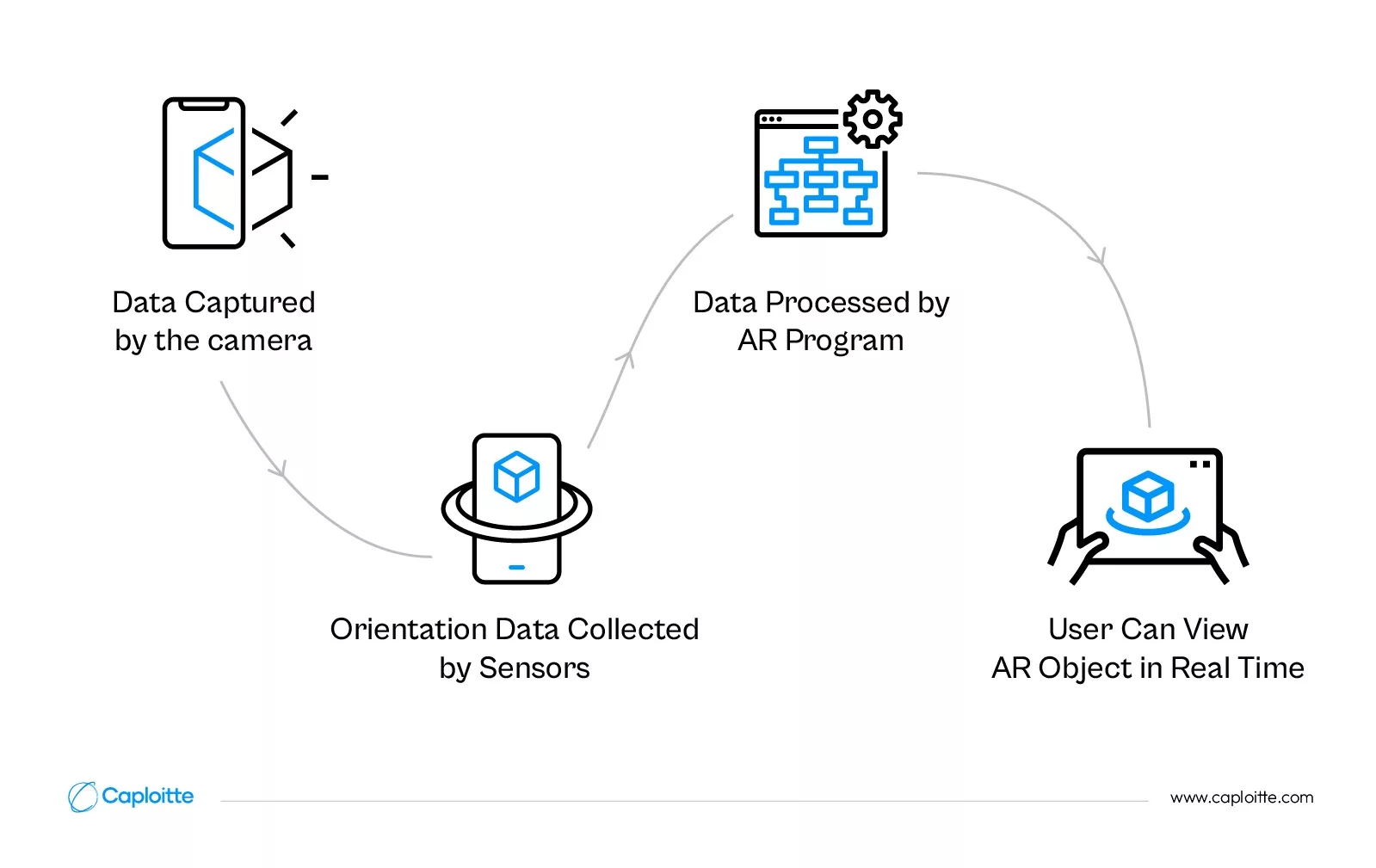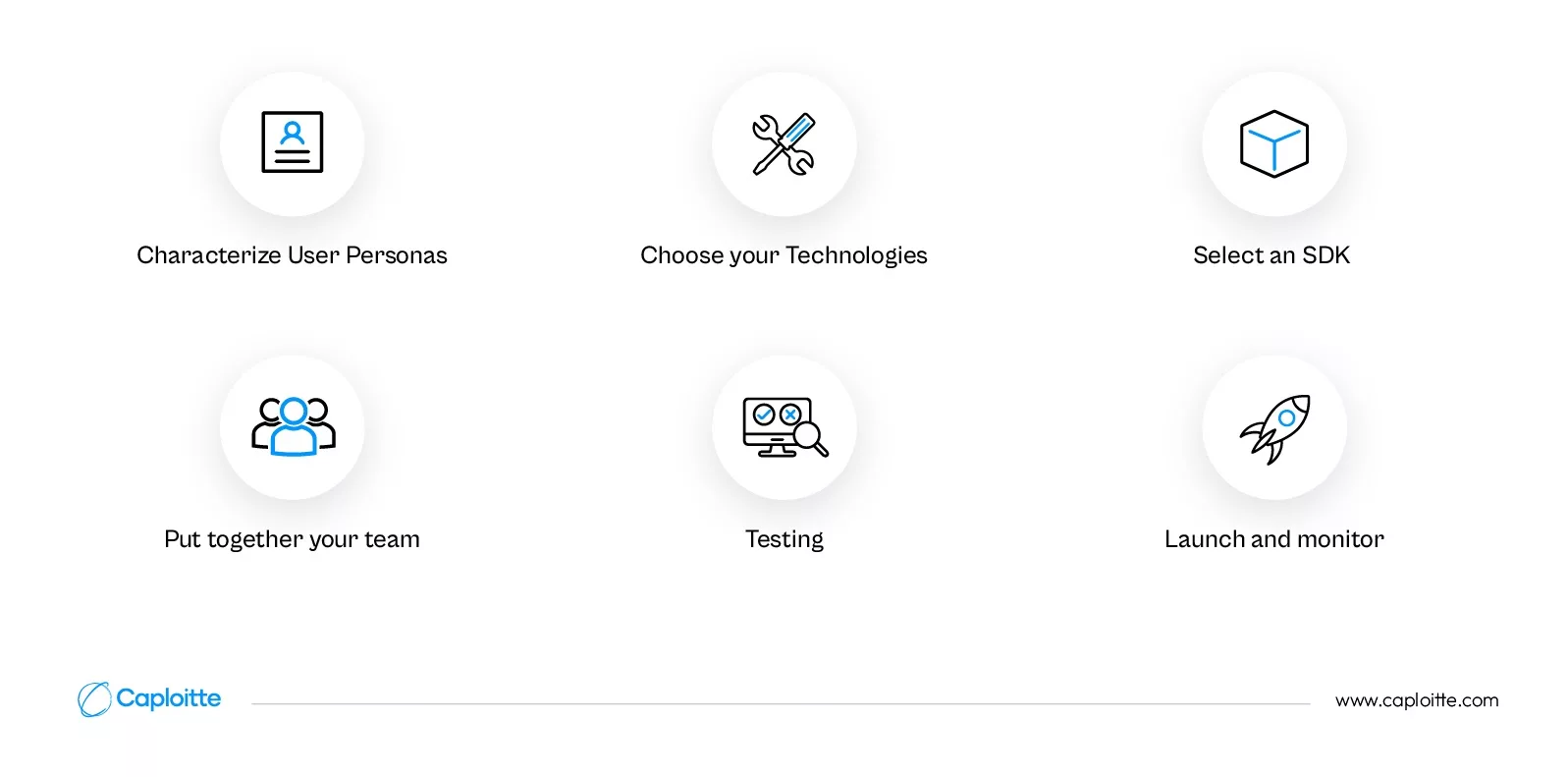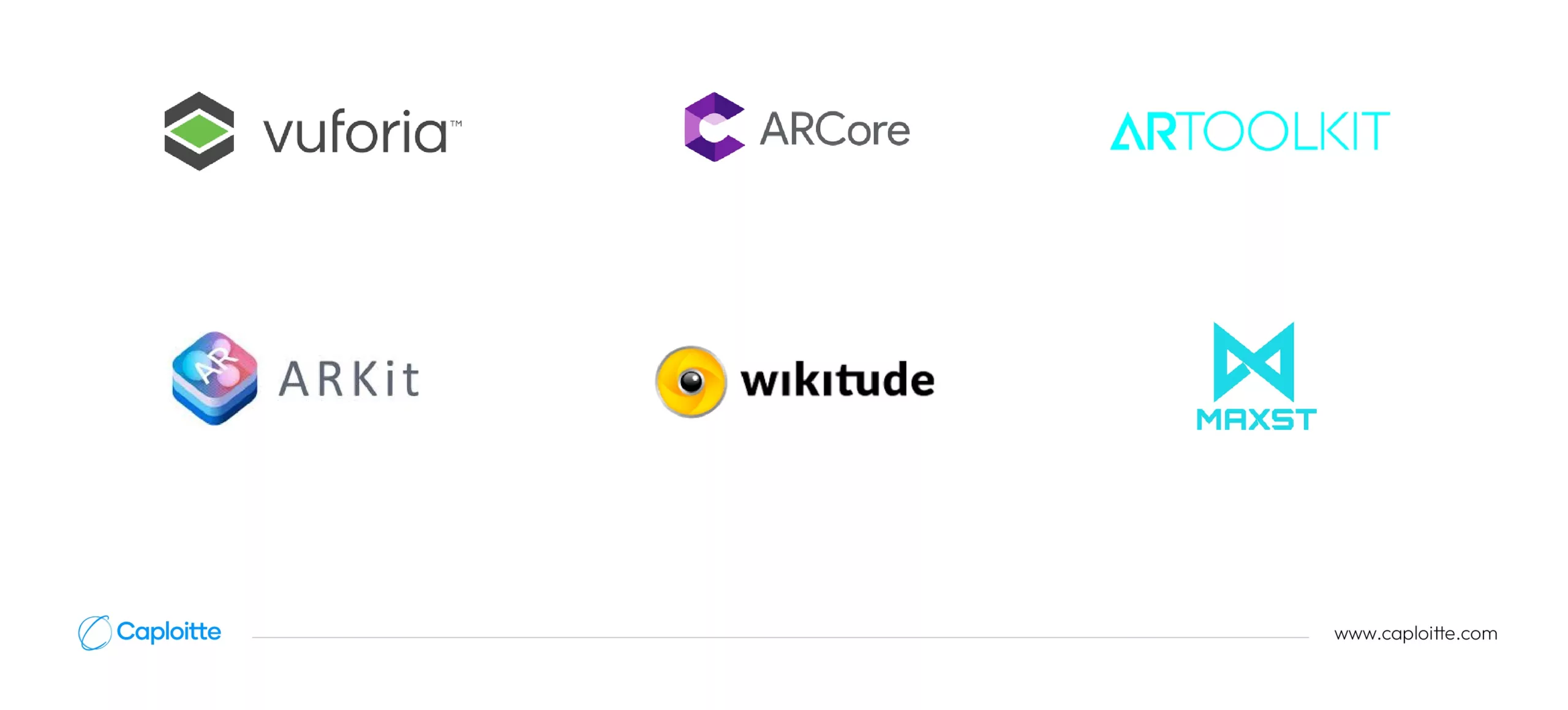Implementing Augmented Reality in Mobile Apps
-
Caploitte
-
19 Feb 2024
-
04 Min Read
What is Augmented Reality (AR)?
How Augmented Reality (AR) function?
What types of applications are there for Augmented Reality?
Industries that AR would help
How to create applications for smartphones for augmented reality
Conclusion
In the digital world, augmented reality (AR) has emerged as the newest trend, and it is rare to come across someone unaware of it. It has begun to redefine user experiences in a variety of industries, including learning and development, online gaming, and commerce. The need for immersive experiences among customers and the expanding availability of AR gear and software are driving the expansion of AR/VR mobile app development. Despite the misconception that augmented reality (AR) is just for enjoyment, it is widely employed in a variety of industries, including healthcare, e-commerce, architecture, and many more.
Let’s deep dive into the world of Augmented Reality (AR)
What is Augmented Reality (AR)?
A technique called augmented reality combines virtual material with the physical world. AR technology creates an augmented reality experience for the user by utilizing a variety of components, including processors, cameras, and sensors. In essence, augmented reality improves the mobile experience by superimposing digital items on top of the user’s physical environment. Businesses use augmented reality (AR) to provide interactive product demos, advertise, and give clients access to real-time information. It has been demonstrated users are more inclined to purchase a product when they touch or come in contact with it because of the emotional connection that is created.
In a nutshell augmented reality (AR) technology in mobile app development combines software, cameras, and sensors to produce an immersive experience that superimposes virtual material on the actual world. Augmented Reality (AR) technology enhances user pleasure and engagement by providing a smooth and engaging experience through precise environment detection and processing. Numerous companies, including Sephora, IKEA Place, Pokémon Go, and many more, are examples of such solutions.
Another technology that is sometimes mistaken for augmented reality is Virtual Reality (VR). Despite the possibility of conceptual similarities, they differ greatly from one another. Using virtual reality headsets or glasses, users may immerse themselves in a virtual environment created via virtual reality while 2D or 3D items are projected onto actual situations in augmented reality systems.
How Augmented Reality (AR) function?

The camera is the first and most important part of AR technology. Real-time environment data is captured by the camera and sent to the augmented reality program. After processing the image, the program determines the location, orientation, and real-world objects.
The sensors are the next crucial element. The device’s orientation, velocity, and position about the earth’s magnetic field are all detected by the magnetometer, gyroscope, and accelerometer. The gadget receives precise location and orientation data from the combination of these sensors.
The augmented reality software projects virtual material onto actual items once the surroundings have been recorded by the camera and other sensors. This material may take the shape of text, animations, or 3D models. To make sure that the virtual content precisely aligns with the real-world items and preserves their position and direction, the program makes use of computer vision and algorithms.
Additionally, AR technology makes use of trackers or markers to locate particular surfaces or objects and superimpose content on them. The camera recognizes markers, which are pictures or QR codes that are used to fix virtual content onto a particular spot or item.
What types of applications are there for Augmented Reality?

Before beginning the building of an augmented reality application, you must select a wide category. Let’s go over their distinctions in brief below.
- Marker-based AR
The foundation of marker-based apps is picture recognition. To show AR material, they employ black and white markers as triggers. Marker-based augmented reality in mobile app development allows users to overlay virtual things on real-world objects by detecting them. The smartphone calculates where to insert virtual content (i.e., mark them) after reading the visual input from the camera. These systems can employ markers that are either 3D or non-3D, such as QR codes. You must point the camera at any location around you to view the augmented component. An app overlays the digital data on the marker when the smartphone identifies it, allowing you to see the augmented object.
- Location-based Applications
Location-based augmented reality apps employ digital compasses, GPS, and accelerometers to determine the user’s location and add augmented reality elements to location-based content. AR apps based on location function without markers. Using a GPS, an accelerometer, or a digital compass, they determine the user’s position and superimpose the augmented reality elements on top of actual locations. Because it is configured to be in particular places, the camera scans the real world and shows items. Without a doubt, Pokemon Go is the most well-known location-based app. In addition to using applications like maps, it may also suggest and generate interesting places to go depending on your search history or present location. Additionally, it may offer tidbits of knowledge and background about a certain location, which is beneficial to visitors and travelers from all over the world.
- Markerless Applications
The most widely used kind of augmented reality application, markerless applications employ a camera to identify patterns in the surrounding world while motion sensors identify surfaces and position 3D objects within the AR. This method eliminates the need for preset patterns or codes. Multiple sensors are used in markerless augmented reality to determine the orientation and location of a mobile device. These sensors include a magnetometer that detects the surrounding magnetic field in all axes, a gyroscope that measures the angular speed around all axes in three dimensions, and an accelerometer that measures the acceleration imparted to the mobile device. In addition to depth sensors, machine learning methods are frequently used to power this kind of augmented reality application. IKEA Place is an example of a markerless AR software.
- Superimposition-based AR
The kind either adds augmented reality to the genuine vision or replaces it. The medical sciences and healthcare sectors are big users of AR apps that use superimposition. Typically, physicians utilize this technology to superimpose an image of a patient’s tissue, bones, muscles, and organs to better assess the damage and administer medical care promptly. In military applications, superimposition is also used to make vital items and targets clearly visible, highlighted, or enhanced with useful features.
Industries that AR would help

Here are several useful commercial advantages of augmented reality (AR) for corporations, even if the data mostly pertains to consumer usage.
- Entertainment
One industry that stands to benefit the most from AR and VR technologies is entertainment. Many companies may use augmented reality (AR) to improve their products or use the technology to modify already-famous games. Consider the advantages of merging the real and virtual worlds in your game.
- Retail and E-commerce
Retailers may integrate digital and physical experiences using AR. Provide a better experience for your mobile-savvy consumers. Enhance your in-store shopping experience without breaking the bank on physical displays. Customers are not only getting what they want from this, but businesses can also react faster by building and installing AR displays far faster than they can with physical modifications.
- Medical Sciences and Healthcare
It offers a multitude of chances for training and procedure execution by healthcare professionals, augmented reality is a potent and useful tool in the creation of healthcare software. Though there are currently a plethora of alternatives for using AR software in research, its usage in healthcare is not new. Augmented reality seems to make a lot of things easier, such as surgical operations, tumor diagnosis, blood flow visualization, and even planning reconstructive surgery treatments.
- Education
VR has a lot to offer to the education sector as well. Learning new knowledge and abilities is made more interesting and remembered with augmented reality. Instead of only viewing two-dimensional images in books, students may interact with and observe 3-D representations of things. It provides a more engaging and more memorable experience than just viewing films and reading books. AR has the potential to significantly improve education since it will enable educators to provide information that pupils will be more receptive to than that of conventional teaching approaches.
- Tourism
You can more readily display the available destinations to consumers as part of the sales process. When you want to get from one area to another, music, video, graphics, and GPS data on a mobile device it will simply send you in the proper path. Additionally, augmented reality (AR) applications can enhance the quality of travelers’ vacations by providing them with more information and an immersive experience once they get to their location. Furthermore, augmented reality (AR) could serve as the ideal platform for brand integration and advertising, opening up hyper-local opportunities and services that would not be feasible in the absence of a location or marker-based AR.
- Real estate
Real estate and architecture provide great potential for augmented reality. Three-dimensional modeling makes it simple to determine if a structural design will work in a particular area.
Generally speaking, developing an augmented reality application will improve your customer communication, no matter what industry you operate in. It will also provide you access to fresh possibilities.
How to create applications for smartphones for augmented reality

Just as with any other mobile app development, the first step in creating an augmented reality application is to identify your company goals. Having a firm understanding of the procedures involved in developing an Augmented Reality app can help you achieve your objectives. If you want to create a successful app, you need to finish these steps:
- Characterize User Personas:
It will assist you in understanding how to approach the market and what features to incorporate.
- Choose your Technologies:
Which approach—web, cross-platform, or native—best suits your needs?
- Select an SDK (software development kit) for augmented reality:
Look at SDKs and the market to select one that meets your needs and budget.
- Put together your team:
Hire a group of developers internally, or contract out an AR development team. Encourage teamwork by distributing the required papers among the members of the team.
- Testing:
Launching an augmented reality app with glitches and freezing is not what you want to accomplish. Test your product’s functionality before showcasing it to prospective customers.
- Launch and monitor:
As soon as your app goes live, keep an eye on user reviews and promptly address any problems that may occur.
Top Augmented Reality SDK for Mobile App Development

After you have a complete understanding of all the capabilities you would need in an SDK to develop an augmented reality application, you can review this list of six widely used tools that are out there.
- Vuforia
With a wide range of capabilities, Vuforia is a top gateway for developing augmented reality applications. Most significantly, it caters to all business sizes and types, from startups to well-known enterprise companies. It is compatible with the following platforms: Unity, Universal Windows Platform, iOS, and Android. Regarding cost Prices for the traditional edition are $499 one-time, $99 monthly for the cloud, and $499 for business use for the Pro version.
- Google ARCore
Google could not pass up the opportunity to provide developers the ability to make augmented reality apps for Android, and for free, given that the operating system has two million active users. Three notable characteristics of Google ARCore are known to help developers combine the real and virtual worlds by estimating lighting conditions in the actual world, measuring item sizes, detecting locations, gauging angles, and tracking motion.
Compatibility: iOS and Android
- ARToolKit
An open-source tool for developing augmented reality apps is called ARToolKit. Despite being a free library, it offers a quite extensive tracking feature set. Platforms supported include Windows, Mac OS, iOS, Android, and smart glasses.
- Apple ARKit
Apple ARKit offers developers and companies a special foundation for building augmented reality apps. Only the iOS and iPadOS operating systems can be used to create AR apps with this SDK. As it makes it easier to access all the capabilities unique to Apple devices, this SDK is excellent for developing native augmented reality apps.
- Wikitude
Wikitude was created specifically to give augmented reality app developers the ability to provide consumers with location-based augmented reality. Then, with the help of its SLAM (Simultaneous Localization and Mapping) technology, it advanced to include picture recognition, tracking, and geolocation app functions. Using a drag-and-drop interface, the SDK offers a no-code environment for creating augmented reality applications.
Compatibility: Windows, iOS, and Android
- MAXST
The Korean AR framework MAXST comes with two distinct software development kits: one for 3D position detection and the other for 2D object tracking.
Due to MAXST’s enhanced support and compatibility with Unity, a game development engine, app developers frequently utilize it to create augmented reality games. Other standard augmented reality functions include picture tracking, environment mapping, and the ability to put digital items in simulations and real-world settings.
Conclusion
It goes without saying that augmented reality technology is trending. The release of a new AR app generates enthusiasm every time. When compared to virtual reality, augmented reality is more practical and has a broader scope. As a result, astute developers are working to become experts in this field and release their own AR applications.
Your consumer experience will be elevated when you offer digitally native experiences that also open up intriguing new avenues for income and marketing. To work on an AR project for your company, though, you’ll need a strong team. If you haven’t ever created an augmented reality product before, be careful to recruit skilled personnel.
Share this post:
Read More
- All
- AI
- AR
- DevOps and CI/CD
- E-commerce
- FinTech
- IoT
- Mobile Development
- Outstaffing
- Security
- SEO
- Tech Trends
- Web Design
- Web Development




